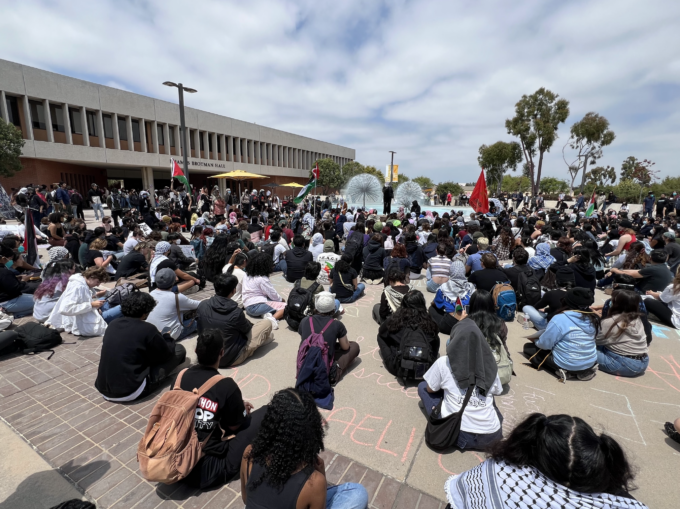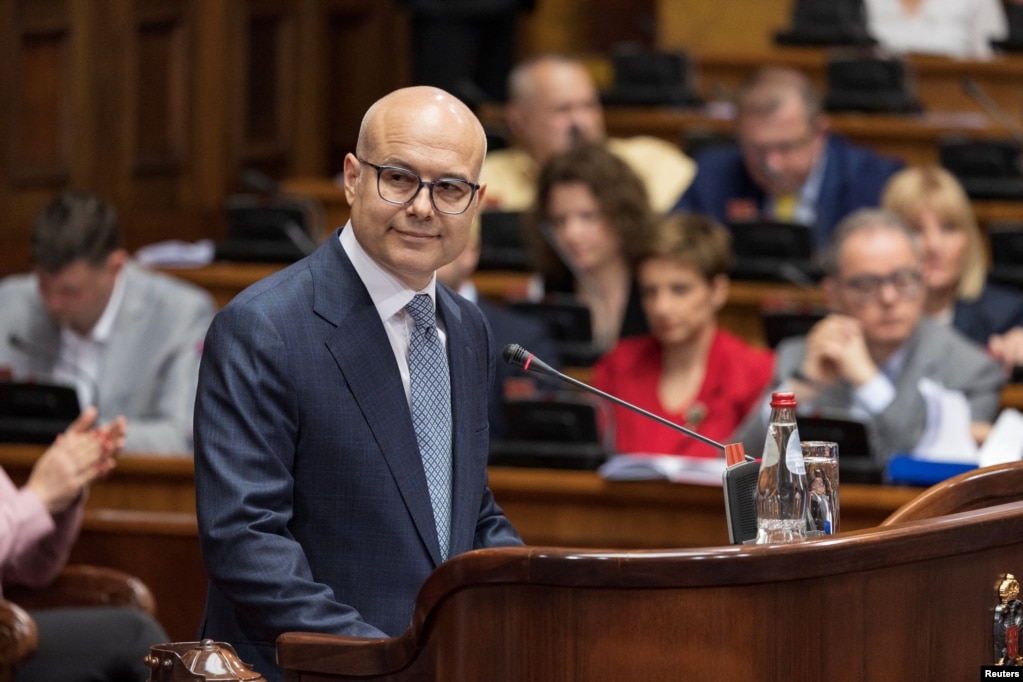Cal State Professors Targeted for Exposing School’s Ties to Israel’s Genocide in Gaza

Cal State Long Beach pro-Palestine protest, May 2, 2024. Photo by Ben Huff.
Last month, in a tangible victory for the BDS (Boycott, Divestment, and Sanctions) movement, San Francisco State University (SFSU) agreed to pull its investment from four companies tied to weapons manufacturing and Israel’s genocide in Gaza. The four include Lockheed Martin, aerospace company Leonardo, military contractor Palantir, and construction equipment maker Caterpillar, whose bulldozers have been tearing up Gaza and the West Bank for decades. The success was four years in the making, as SFSU students successfully passed a divestment resolution in 2020.
“I want to thank all the work group participants who dedicated time this summer to the creation of this plan, including the representatives from Students for Gaza and members of our Investment Committee,” said SFSU Vice President Jeff Jackanicz.
While the sun may be setting on SFSU’s complicity in Israel’s genocidal mayhem, the situation isn’t as pleasant at Cal State Long Beach (CSULB), the second-largest school in California’s Cal State system, despite that students passed a similar divestment resolution in 2017. School administrators have done their best to stifle criticism of Israel and recently went as far as to send an email warning five faculty members for allegedly violating the school’s 2023-2024 “Time, Place, Manner” (TPM) rules by using a megaphone and a microphone at a Palestinian solidarity protest. While students have been cited in the past, this appears to be the first time professors have been accused of violating the policy.
As college protests erupted around the country, over 500 pro-Palestine activists and dozens of faculty at CSULB held a teach-in on May 2. While many other faculty spoke at the peaceful teach-in on a megaphone, only five were targeted for their participation. The professors, all members of CSULB FJP, are predominantly faculty of color and disproportionately Muslim. They include Araceli Esparza, Professor of English; Jake Alimahomed-Wilson, Professor of Sociology; Azza Basarudin, Associate Professor of Women’s, Gender, and Sexuality Studies; Sabrina Alimahomed-Wilson, Professor of Sociology, and Steven Osuna, Associate Professor of Sociology.
“We were all hired because of our academic training in questions of race and racism both in the US and abroad and we are now being targeted for drawing on our expertise to take a stand against militarism and genocide in Gaza, suggesting that our viewpoints are only welcome if administrators agree with us,” explains Prof. Araceli Esparza. “As scholars focused on US empire and colonialism, we are taking the only ethical position available to us at this moment of US-supported genocidal violence in Gaza and we will continue to call for an end to the genocide against the people of Palestine all while facing attempts to repress our constitutionally protected rights to free speech and academic freedom.”
The professors, whose supporters are calling “the CSU-5,” appear to have been targeted, not because they amplified their voices at a campus protest but because, along with another faculty member, they co-wrote a critical piece for Mondoweiss and CounterPunch. The sixth professor did not speak at the May 2nd protest.
The widely read piece exposed CSULB’s ties to Boeing and other defense contractors’ complicity in Israel’s genocide against Palestinians. In their essay, “Boeing University: How the California State University Became Complicit in Palestinian Genocide,” the faculty writes:
Despite its complicity in occupation and genocide, Boeing has had a long and financially reciprocal relationship with CSULB, one going back decades with its latest iteration being touted as CSULB’s “Boeing Partnership.” CSULB is one of just 16 universities nationwide – and the sole university in California – to be selected by the Boeing Company for an exclusive university partnership. The Boeing Partnership is a university-corporate alliance that has further transformed CSULB into a public relations mouthpiece for the defense contractor. The CSULB-Boeing partnership illustrates not only how defense contractors such as Boeing, Raytheon, and Northrop Grumman profit from Israel’s violence against Palestinians, but also how these massive corporations simultaneously undermine the mission of public universities by harming students domestically and facilitating genocide, militarism, and mass death abroad.
CSULB President Jane Close Conoley has a lengthy track record of stifling criticism of Israel on campus. During the 2017 student senate vote on divestment, Conoley penned an op-ed for the school’s newspaper condemning the resolution to divest from corporations with direct ties to the Palestinian occupation and genocide. At the time, faculty members argued that Conoley had a “chilling effect” on free speech by inserting herself into the debate. Despite the resolution passing (15, 7, 1) in a roll call vote, Conoley effectively killed the legislation by refusing to enforce it. What did Conoley get for silencing the divestment vote? Recognition for her excellent work from the Orange County/Long Beach branch of the pro-Israel Anti-Defamation League (ADL) later that year.
“Since coming to Long Beach as president, I have been blessed with many recognitions (e.g., from LAEDC, ADL, NAACP), which both humbled me and made me proud,” Conoley told the Long Beach Business Journal in 2018.

The fact that Conoley is cozy with the ADL should be cause for concern. The organization deems nearly all opposition to Israel, including divestment, as anti-semitism. Early this year, ADL President Jonathan Greenblatt dangerously claimed that Jewish Voice for Peace (JVP) and Students for Justice in Palestine (SJP) are “Iranian proxies” equivalent to Hezbollah. Unsurprisingly, like the ADL’s Greenblatt, President Conoley believes pro-Palestine protests on college campuses are in “support of the awful terror attacks on Israel by Hamas.”
Conoley makes good money squelching pro-Palestine voices from her campus perch while she oversees the crackdown on the free speech of students and faculty protesting genocide. In 2022, she made $479,505, a 7% jump from 2021. In addition to her salary, she enjoys luxury housing that is paid for by the university.
“[While] Conoley has used her platform for many years to freely express her pro-Israel perspective without any fear of retaliation or harassment, unfortunately, this has not been the case for pro-Palestine faculty and students,” claims Prof. Jake Alimahomed-Wilson. “In contrast, we face increasing hostility, harassment, and apparently now an unequal enforcement of the university’s restrictive Time, Place, and Manner policy when we exercise our constitutionally protected speech to oppose the ongoing genocide in Gaza.”
Conoley also recently spoke at an ADL co-sponsored event last April called “Shining a Light,” where she addressed the crackdown on alleged campus antisemitism.
The Southern California branch of the American Civil Liberties Union (ACLU) has condemned the targeting of the CSU-5. In a letter to Patricia A. Pérez, Associate Vice President of Faculty Affairs, ACLU free speech staff attorney Jonathan Markovitz argues, “[the university’s] policy very likely violates the First Amendment and Liberty of Speech Clause of the California Constitution … I am also concerned by the possibility that the University may have sent the warning … because of disapproval with their political positions, or with the fact that they have been outspoken in defense of Palestinian rights in the past.”
Sadly, CSULB isn’t the only school working to silence students speaking out against the genocide in Gaza. Last week, two Columbia University student protestors were arrested, and several other Columbia faculty members were targeted, including Jewish law Prof. Katherine Franke, who is now facing termination. Columbia banned JVP and SJP chapters from campus, and NYU (my alma mater) has opened over 180 disciplinary cases against pro-Palestine students and faculty. The list goes on…
It doesn’t seem to matter that the actions of these universities are antithetical to the very project of academia. “Academic freedom protects and nurtures the intellectual pursuit of knowledge and justice,” says CSULB Associate Prof. Azza Basarudi. “We are guided by the principle that knowledge production is inherently critical of colonial and imperial projects and repressive power structures.”
In addition to notifying faculty that they had allegedly violated the TPM policy, students must also abide by the rules of a new interim TPM. On August 19, Cal State’s Chancellor’s Office sent a system-wide email to all 23 California State Universities stating that no encampments would be allowed on campus. Students are now prohibited from blocking access to buildings or wearing face coverings to conceal their identities. While the TPM immediately applies to Cal State students, the updated TPM does not impact faculty until their union, the California Faculty Association (CFA), meets and confers with university management. Implementing this TPM before the union agrees to the policy changes, say CFA representatives, violates California’s Higher Education Employer-Employee Relations Act (HEERA).
However, the CSU-5 is being accused of violating the old 2023-2024 TPM in what they believe is apparent retaliation for their piece on Cal State Long Beach’s ties to Boeing.
“There cannot be a Palestine exception to academic freedom,” adds Prof. Azza Basarudim, who admits they won’t stop until the genocide stops. “The university’s role is to support faculty and students, not to give in to pressure and interference from external donors, corporations, alums, and political lobbyists.”
If there’s a silver lining to all of these attacks on free speech, it’s that efforts to stifle dissent are only likely to backfire and reinvigorate the pro-Palestine movement on college campuses. As long as children continue to be killed in Gaza and blood is shed in the West Bank, a new generation of students and professors of conscience like the CSU-5 will rise to pressure their employers to sever ties with industries that profit from genocide.




